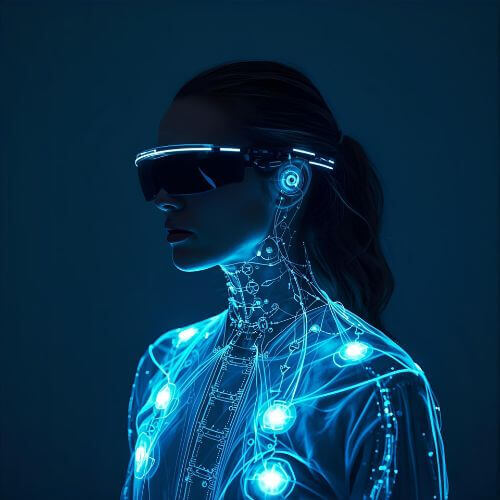Have you ever thought of your wearable device as a personal assistant, silently working behind the scenes to improve your health? Just like a trusty sidekick, wearable devices have transformed from being simple tech gadgets into vital tools for monitoring our health.
They’re like your health guardian, always with you, ready to provide insights and alerts. So, the real question is: are wearable devices the future? Yes vs No. For me, the answer is crystal clear—yes. Wearables are not just for today; they are the backbone of tomorrow’s health and wellness.
What Are Wearable Devices?
Wearable devices are electronic gadgets designed to be worn on the body, either as accessories, embedded into clothing, or as standalone items. These devices combine microprocessors, sensors, and often wireless communication technology to collect, process, and share data in real-time.
Whether tracking fitness, monitoring health, or enabling communication, wearables have become an essential part of modern life. Popular examples include smartwatches, fitness trackers, smart glasses, and even smart clothing, each offering unique functions and benefits.
These devices work through a combination of sensors, data processing, and connectivity. Equipped with various sensors such as motion detectors, heart rate monitors, and GPS, wearables collect data about the user or their environment.
The data is then processed by the device’s internal processor, often in real-time, and shared through connectivity with smartphones or directly with the internet for further analysis. This functionality makes them invaluable for tasks like health monitoring and personal tracking.
Common examples of wearable devices include smartwatches, fitness trackers, smart glasses, Tesla Grounding and smart clothing. Smartwatches worn on the wrist track fitness, display notifications, and enable calls. Fitness trackers, often worn as wristbands or clips, focus on physical activity and health metrics like steps and heart rate.
Smart glasses offer augmented reality or informational displays, while smart clothing integrates electronics for monitoring biometrics or providing other advanced functionalities. These devices are transforming how we interact with technology, making daily life more connected and data-driven.
When Did Wearable Devices Become Mainstream?
Wearable devices began to gain significant traction in the 2010s, marking a pivotal shift in their mainstream adoption. While earlier technologies like Bluetooth headsets and GPS watches laid the foundation in the 2000s, it wasn’t until the 2010s that wearables truly exploded in popularity.

The introduction of fitness trackers such as the Fitbit Flex in 2013 and the launch of the Apple Watch in 2015 were key milestones, bringing these devices into the spotlight and making them accessible, sophisticated, and user-friendly for a much wider audience.
Throughout the 2010s, fitness trackers like the Jawbone UP and Fitbit Flex rapidly gained traction, with sales accelerating as more people began to embrace activity tracking. This period saw fitness monitoring shift from niche markets to mass appeal, with these devices offering accessible, real-time insights into physical health.
Meanwhile, smartwatches—once a concept limited to a few tech enthusiasts—became mainstream with the debut of the Apple Watch. Combining both fashion and function, these smartwatches allowed users to receive notifications, access apps, and track health metrics, sparking a wave of interest from a broader demographic.
As wearable technology evolved, it grew increasingly sophisticated and integrated. Devices began incorporating advanced features such as heart rate monitoring, GPS, and sleep tracking, enhancing their functionality beyond basic activity tracking. Major companies like Google and Apple invested heavily in this sector, pushing the boundaries of what wearables could offer.
By 2014, one in five American adults owned a wearable device, and public perception shifted from skepticism to a more positive view, with many considering these devices not only “interesting” and “fun” but also highly “convenient” and valuable for improving everyday life.
What Are the Most Popular Wearable Devices?
Here’s a breakdown of the most popular wearable devices today:
| Device | Description | Key Features |
|---|---|---|
| Apple Watch Ultra 3 | A top-tier smartwatch that combines cutting-edge health features with a sleek design. | ECG monitoring, blood oxygen levels, satellite connectivity, fitness tracking. |
| Samsung Galaxy Watch 8 | Known for its stylish design and excellent health tracking, it’s perfect for Android users who want an all-in-one device. | Advanced fitness tracking, sleep monitoring, integration with Android phones, long battery life. |
| Amazfit GTR 4 | A budget-friendly option that offers a range of health features while maintaining impressive battery life. | Fitness tracking, heart rate monitoring, sleep tracking, budget-friendly pricing. |
Wearable Devices: Implications for Precision Medicine and the Future of Healthcare
Predictive Health Monitoring and Diagnosis
- ML will enable wearables to identify early signs of health issues, moving from reactive care to proactive, predictive health management.
- Disease Detection: Wearables will monitor a range of biosignals (e.g., heart rate variability, temperature) to predict conditions like atrial fibrillation, sleep apnea, and even infectious diseases like COVID-19.Remote Patient Management: AI-powered wearables will continuously monitor vital signs for chronic conditions (e.g., diabetes management) and recovery from surgery.
- Neurological Applications: ML will forecast conditions like epilepsy by analyzing movement patterns, gait, and tremors; also assisting in diagnosing diseases like Parkinson’s.
- Mental and Emotional Well-being: Wearables will monitor stress, anxiety, and emotional shifts by tracking heart rate variability and electrodermal activity, offering personalized mental health support.
Advanced Personalized Fitness and Lifestyle Coaching
- Customized Training: Wearables will analyze user activity and biometrics to create personalized workout routines and adjust them in real-time for optimal fitness and injury prevention.
- Holistic Wellness Insights: Future wearables will track not only steps but also sleep, nutrition, and exercise, providing a comprehensive view of health and actionable advice.
- Enhanced User Experience: ML algorithms will predict user needs and adapt the device’s interface and features, making the wearables more intuitive and context-aware.
Enhanced Productivity and Decision-Making
- Cognitive Load Management: AI-powered wearables will monitor stress indicators to help users, such as military pilots, filter non-critical information for better focus and decision-making.
- Workplace Safety: AI-enabled wearables like helmets will monitor workers’ vital signs to detect fatigue, sending real-time alerts to prevent accidents.
- Daily Life Decisions: ML-powered wearables will learn habits and provide proactive notifications and recommendations, such as suggesting a faster route home based on traffic data.
Challenges and Limitations
- Data Privacy and Security: Strong encryption and transparent data policies are needed to protect sensitive personal information and build user trust.
- Model Accuracy and Bias: Ensuring the accuracy of ML models requires diverse, high-quality training data; algorithmic bias can lead to unfair or inaccurate health insights.
- Hardware and Battery Life: Wearables face limitations in processing power and battery life, necessitating optimization of ML algorithms for better performance.
- Interoperability: Lack of standard protocols can hinder device integration, preventing a unified view of a user’s health.
- User Dependence and Trust: Over-reliance on AI recommendations could limit user decision-making. Education on limitations is necessary to ensure users understand these technologies.
The Future Outlook
- New Hardware: Advances in materials science (e.g., flexible electronics and smart textiles) will make wearables more comfortable and seamlessly integrated into daily life.
- Edge Computing: Processing data on the device (rather than the cloud) will reduce latency, enhance privacy, and improve real-time performance.
- Brain-Computer Interfaces (BCIs): The future may involve wearables that interact with the brain through thought, with AI interpreting neural signals.
- Platform Integration: Wearables will become central hubs in an interconnected IoT ecosystem, seamlessly coordinating with smartphones, smart homes, and other devices to anticipate and respond to user needs.
RFK Jr. Said About Wearable Devices
Robert F. Kennedy Jr. believes in the power of wearable devices to transform public health, much like how a compass guides a sailor through rough waters. He sees wearables as a tool that will empower individuals, allowing them to monitor their health in real-time.
Just as a chef relies on precise measurements to perfect a dish, RFK Jr. envisions wearable devices the future providing us with precise data to make better health decisions. In this way, wearable devices the future could reduce the burden on healthcare systems while enabling individuals to take charge of their health.
Wearable Devices: Implications for Precision Medicine and the Future of Healthcare
Wearable devices the future hold incredible potential for precision medicine. Imagine a tailor creating a custom suit to fit you perfectly—wearable devices could do the same for your healthcare. By tracking your unique health data, wearables enable doctors to personalize your treatment plans based on real-time information, resulting in more effective treatments and fewer side effects.
In this way, wearable devices the future will allow us to move away from a one-size-fits-all approach to medicine, tailoring solutions specifically for individuals. This shift could revolutionize healthcare, making treatments more efficient and accurate.
Comparison Table: Wearable Devices the Future vs. Present Wearables
| Feature | Present Wearables | Wearable Devices the Future |
|---|---|---|
| Health Monitoring | Tracks steps, calories, heart rate | Advanced health metrics (glucose, ECG, brain activity) |
| Data Processing | Simple data collection | Real-time data analysis with AI and machine learning |
| Proactive Health Alerts | Basic alerts (e.g., heart rate anomalies) | Early detection of diseases with predictive capabilities |
| Battery Life | 1-3 days on a single charge | Longer battery life with energy-efficient technology |
| Integration with Healthcare | Syncs with apps for tracking | Seamless integration with healthcare providers for real-time monitoring |
| Personalization | Basic customization (goals, activity tracking) | Highly personalized health plans based on collected data |
The Future of Wearable Devices: Market Growth, Technology Advancements, and Their Transformative Impact

Looking ahead, wearable devices the future are expected to experience exponential growth. The global market is forecasted to reach USD 186.14 billion by 2030, driven by technological advancements like AI and machine learning, alongside the growing demand for personalized health tracking. With the rise of more accessible, user-friendly wearables, it’s like watching a rocket ready to launch—wearable devices the future are set to take off in ways we can only imagine.
The future of wearable technology is incredibly bright. As wearables evolve with longer battery life, advanced sensors, and deeper integration with artificial intelligence, these devices will do more than just track health—they will predict, personalize, and revolutionize how we approach personal wellness. Picture the dawn of a new age in healthcare, where wearables become central to the future of medicine, providing real-time, actionable health insights and offering better prevention and care.
I believe that wearable devices the future will be transformative. Just as smartphones evolved from basic calling tools into essential devices for nearly every aspect of our lives, wearables will continue to grow and integrate seamlessly into our daily routines. They’ll be smarter, more intuitive, and offer deeper health insights, all while becoming more accessible to people around the world. As technology advances, wearables will become even more embedded into the fabric of modern life, shaping the future of how we live and care for our health.
FAQs
Are wearable devices accurate in health monitoring?
Yes, wearable devices are generally quite accurate, but they should complement professional medical advice rather than replace it.
How do wearable devices help with fitness tracking?
They track your steps, heart rate, sleep, and more, helping you understand your fitness levels and progress.
Are wearable devices safe to use?
Yes, as long as you follow the manufacturer’s guidelines, wearable devices are safe for most users.
Do I need a smartphone to use a wearable device?
Some wearables work independently, but many offer enhanced features when paired with a smartphone.
Can wearables detect early signs of diseases?
Yes, wearables can monitor health metrics and send alerts if something seems off, but they are not a substitute for medical diagnoses.
Are Wearable Devices the Future of Precise Antibiotic Dosing?
Yes, wearable devices the future could play a major role in precise antibiotic dosing. Imagine wearing a device that tracks antibiotic levels in your bloodstream, adjusting the dosage in real-time to ensure you get the right amount. It’s like having a personal pharmacist at your side, making sure your medication is as effective as possible, without the risk of overmedication or underdosing.
This technology could be crucial in the fight against antibiotic resistance, ensuring that patients receive the optimal dose for their condition.
Conclusion
Wearable devices the future are not just a passing trend—they are the next big thing in health and wellness. From tracking our steps to predicting potential health risks, these devices are already changing the way we live. With advancements in technology, wearables will become smarter and more integrated into our daily lives, making them essential tools for improving our health. So, are wearable devices the future? Yes, and the future is already here!


